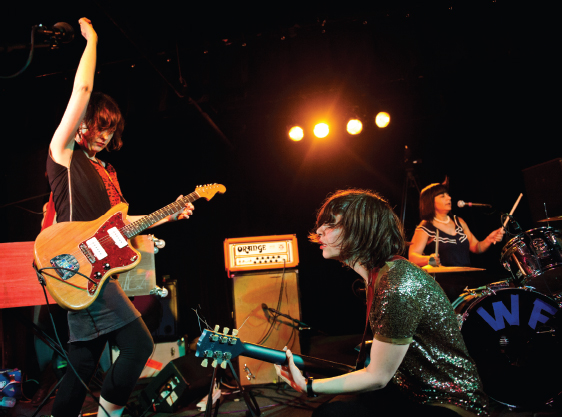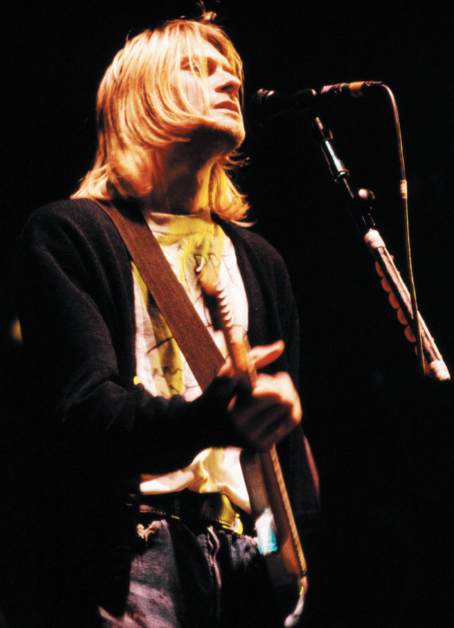Punk, Grunge, and Alternative Respond to Mainstream Rock
“Through their raw, nihilistic singles and violent performances, the [Sex Pistols] revolutionized the idea of what rock and roll could be.”
STEPHEN THOMAS ERLEWINE, ALL-MUSIC GUIDE, 1996
By the 1970s, rock music was increasingly viewed as just another part of mainstream consumer culture. With major music acts earning huge profits, rock soon became another product line for manufacturers and retailers to promote, package, and sell—primarily to middle-class white male teens. According to critic Ken Tucker, this situation gave rise to “faceless rock—crisply recorded, eminently catchy,” featuring anonymous hits by bands with “no established individual personalities outside their own large but essentially discrete audiences” of young white males.17 Some rock musicians like Bruce Springsteen and Elton John; glam artists like David Bowie, Lou Reed, and Iggy Pop; and soul artists like Curtis Mayfield and Marvin Gaye continued to explore the social possibilities of rock or at least keep its legacy of outrageousness alive. But they had, for the most part, been replaced by “faceless” supergroups like REO Speedwagon, Styx, Boston, and Kansas. By the late 1970s, rock could only seem to define itself by saying what it wasn’t; “Disco Sucks” became a standard rock slogan against the popular dance music of the era.
Punk Revives Rock’s Rebelliousness

After a few years, punk rock rose in the late 1970s to challenge the orthodoxy and commercialism of the record business. By this time, the glory days of rock’s competitive independent labels had ended, and rock music was controlled by just a half-dozen major companies. By avoiding rock’s consumer popularity, punk attempted to return to the basics of rock and roll: simple chord structures, catchy melodies, and politically or socially challenging lyrics. The premise was “do it yourself”: Any teenager with a few weeks of guitar practice could learn the sound and make music that was both more democratic and more provocative than commercial rock.
The punk movement took root in the small dive bar CBGB in New York City around bands such as the Ramones, Blondie, and the Talking Heads. (The roots of punk essentially lay in four pre-punk groups from the late 1960s and early 1970s—the Velvet Underground, the Stooges, the New York Dolls, and the MC5—none of whom experienced commercial success in their day.) Punk quickly spread to England, where a soaring unemployment rate and growing class inequality ensured the success of socially critical rock. Groups like the Sex Pistols, the Clash, the Buzzcocks, and Siouxsie and the Banshees sprang up and even scored Top 40 hits on the U.K. charts.
Punk was not a commercial success in the United States, where (not surprisingly) it was shunned by radio. However, punk’s contributions continue to be felt. Punk broke down the “boy’s club” mentality of rock, launching unapologetic and unadorned frontwomen like Patti Smith, Joan Jett, Debbie Harry, and Chrissie Hynde; and it introduced all-women bands (writing and performing their own music) like the Go-Go’s into the mainstream. It also reopened the door to rock experimentation at a time when the industry had turned music into a purely commercial enterprise. The influence of experimental, or post-punk, music is still felt today in alternative bands such as the Yeah Yeah Yeahs, Wild Flag, and Dirty Projectors.
Grunge and Alternative Reinterpret Rock

Taking the spirit of punk and updating it, the grunge scene represented a significant development in rock in the 1990s. Getting its name from its often messy guitar sound and the anti-fashion torn jeans and flannel shirt appearance of its musicians and fans, grunge’s lineage can be traced back to 1980s bands like Sonic Youth, the Minutemen, and Hüsker Dü. In 1992, after years of limited commercial success, the younger cousin of punk finally broke into the American mainstream with the success of Nirvana’s “Smells Like Teen Spirit” on the album Nevermind. Led by enigmatic singer Kurt Cobain—who committed suicide in 1994—Nirvana produced songs that one critic described as “stunning, concise bursts of melody and rage that occasionally spilled over into haunting, folk-styled acoustic ballad.”18 Nirvana opened up the floodgates to bands such as Green Day, Pearl Jam, Soundgarden, the Breeders, Hole, Nine Inch Nails, and many others.
In some critical circles, both punk and grunge are considered subcategories or fringe movements of alternative rock. This vague label describes many types of experimental rock music that offered a departure from the theatrics and staged extravaganzas of 1970s glam rock, which showcased such performers as David Bowie and Kiss. Appealing chiefly to college students and twentysomethings, alternative rock has traditionally opposed the sounds of Top 40 and commercial FM radio. In the 1980s and 1990s, U2 and R.E.M. emerged as successful groups often associated with alternative rock. A key dilemma for successful alternative performers, however, is that their popularity results in commercial success, ironically a situation that their music often criticizes. While alternative rock music has more variety than ever, it is also not producing new mega-groups like Nirvana, Pearl Jam, and Green Day. Still, alternative groups like Arctic Monkeys, Vampire Weekend, and MGMT have launched successful recording careers the old-school way, but with a twist: starting out on independent labels, playing small concerts, and growing popular quickly with alternative music audiences through the immediate buzz of the Internet.